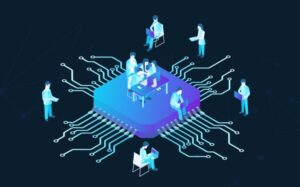
Successful brainstorming leads to valuable innovation. A robust ideation process designed to create solutions to problems in the landscape is essential for success. Yet, many organizations struggle with quickly and easily finding solutions, as well as developing new ideas that haven’t been done before. According to IP.com’s own research, more than half of organizations feel one of these struggles is the biggest challenge of the entire invention process.
This shaky foundation is likely limiting success throughout the innovation lifecycle. Without a brainstorming workflow that produces quality ideas en mass, there are fewer options for engineers to work with as they move toward developing and patenting novel solutions. Remedying these challenges may be as simple as introducing a new team member to the brainstorming process: artificial intelligence.
Brainstorming with AI
The structured nature of brainstorming makes it a great opportunity to engage AI. Adding a machine into the mix might not come naturally to every R&D team. However, with the right parameters and expectations, AI brainstorming can change the way organizations move through the invention process. Before adding an AI-backed brainstorming tool (like IQ Ideas™) into the ideation process, businesses will need to address these three considerations.
1. AI needs a well-described problem.
Describing the problem or opportunity your idea needs to solve is helpful for human brainstorming. A clearly defined problem is absolutely essential for AI, which works best within a set of relevant rules.
2. AI needs to be trained to brainstorm.
Not all AI is created equal. For successful AI-assisted brainstorming, you need an algorithm trained on the type of information you’ll be inputting. This can even vary by industry and task; not all brainstorming is the same. For example, you might need your AI to consider product development, branding, or copywriting. IP.com’s IQ Ideas is specifically designed to help engineers come up with novel, and therefore patentable, solutions based on existing technical literature.
3. AI is just one part of a team.
It’s unrealistic to rely solely on an AI brainstorming tool to solve your company’s (or industry’s) problems. Rather, AI is just one part of a collaborative ideation process. There are functional, ethical, and legal limits to AI as an inventor. IP Ideas helps engineers find new places to look for solutions. One of AI’s distinct advantages over humans is the ability to quickly comb through massive datasets for relevant information. Human inventors can apply relevant patents, discovered by AI based on a clearly defined problem, to new problems. The result is potentially novel ideas inspired by existing solutions, a system based on TRIZ methodology and enhanced by AI.
Source: https://ip.com/blog/3-considerations-for-brainstorming-with-ai/- AI
- algorithm
- All
- artificial intelligence
- BEST
- Biggest
- businesses
- challenge
- change
- Development
- discovered
- Engineers
- great
- HTTPS
- Humans
- idea
- industry
- information
- Innovation
- Intelligence
- IP
- IT
- literature
- move
- Opportunity
- Options
- Patents
- Product
- product development
- quality
- R&D
- research
- rules
- set
- Simple
- Solutions
- SOLVE
- success
- successful
- system
- Technical
- The Landscape
- within
- Work
- workflow
- works


